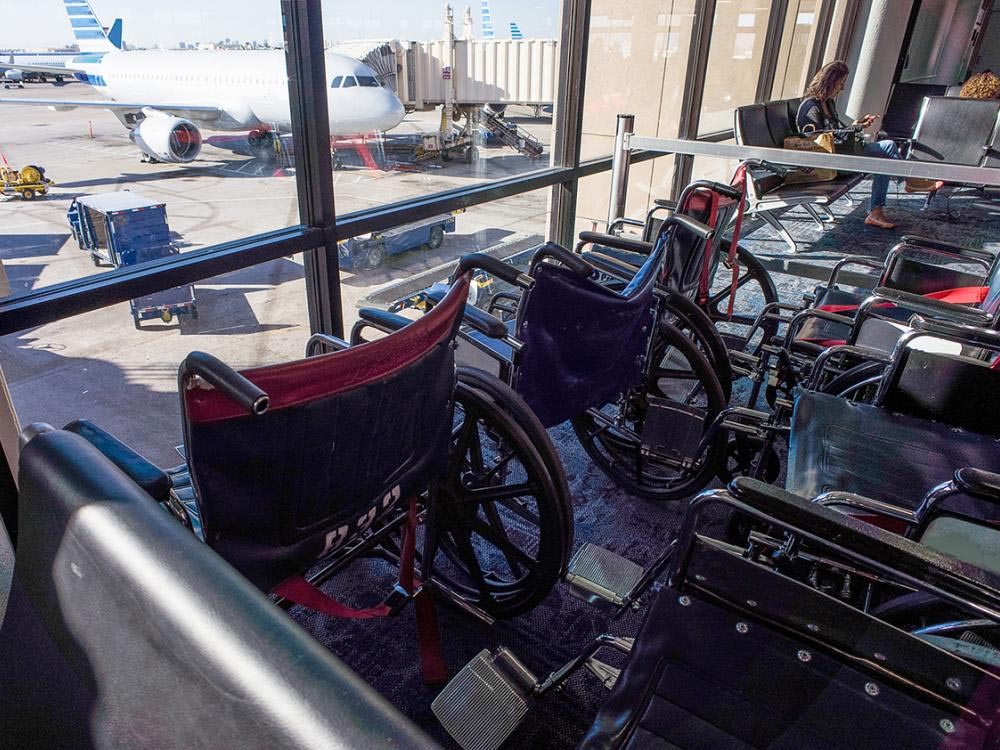
And the airline can be allowed to plug in a regular airline seat into the docking spot whenever a wheelchair is not in use. Dedicating one or two front-row seats for wheelchair docking spots is a solution, so that the disabled wheelchair passenger can travel sitting in one’s own wheelchair, which can be de-docked quickly during an emergency. It is just a lack of commitment among airlines to solve the problem. In the event of a crash, the disabled passenger would have a better chance of getting off the plane if one just had to unhook a lever quickly, than if his/her wheelchair was stowed in the luggage bin of the plane. If the wheelchair gets damaged due to mishandling in transit, the passenger would be stranded upon arrival, with no way to get around. Mishandling a wheelchair can put the electronic controls at risk. The ground crew of airlines need to stow the wheelchairs with utmost care in the luggage hold, and treat them as a very delicate cargo, and definitely not the way most luggage pieces travel. Wheelchairs with power controls operated by the user, unaided, can be quite expensive. When wheelchairs arrive damaged at their destination, the airlines/airports claim no responsibility. Why can’t airlines provide the requisite facilities on board to the disabled, even if against payment, such as dedicated slots in the aircraft where wheelchairs can be secured, and the disabled passengers who own them can use them as seats for air-travel? But it is harsher on the disabled, some of whom need the extra few inches for maneuverability. That puts even normal passengers to difficulty on long-haul flights. Commercial angle has also led to continual reduction of leg-space between rows of seats to put additional seats.

for food being served, for any excess baggage beyond the permitted allowance, and for choice of seats like isle- or a window-seat. why do the airlines remain untouched?Ĭurrently, airlines charge extra for services to beat the losses, viz. With so much awareness to cater to the needs of the disabled traveling by taxis, buses, trains, etc.
Cabin wheelchair restraint systems driver#
The charges of a taxi-hailing service for the disabled in Bangalore include the service by the driver to help the passenger board and keep the wheelchair securely in the dickey. 93 percent of train stations in Tokyo have step-free access, 96 percent have universal-access toilets and all have tactile paving! Though they would stay at Athletes’ Village, they will go around the city, too. Around 4,300 Paralympic athletes would arrive in Tokyo. 6 Tokyo Paralympics in 2020 as a catalyst to make the city accessible for wheelchair users. The city of Tokyo has made comprehensive plans to use the Aug. When the passenger gave an OK signal, the driver would press a button to close the rear door, and move on to pick up the next wheelchair office-goer. While sitting in his wheelchair, the passenger would dock the wheelchair to secure it to the vehicle floor, as well as to a side-railing, immobilizing it for safety in the moving van. The passenger would then maneuver his/her powered wheelchair to go up the ramp into the van. The driver kept sitting in his seat, and pressed a button to open the rear gate of the van, and to lower a ramp down to the road level. The van took 4 wheelchair passengers to their respective offices. Each morning a passenger van pulled up near my residence to pick up an office-goer who was on wheelchair. Visiting Toronto in 1988, I was impressed to see the care being given to the disabled wheelchair riding citizens. Many disabled passengers are physically carried onto the plane, and transferred onto a seat. Some wheelchair users have a serious disability making them use a motorized custom-designed wheelchair, which they need to give up at the entrance of the plane. Imagine getting dehydrated on long-haul flights, besides it being a dehumanizing experience. Second, not being able to use a toilet on aboard.

First, the fear that the wheelchair might get damaged in transit, a not so uncommon occurrence that can create serious mobility issues. Air travel continues to be a challenge for wheelchair using disabled passengers, mainly for two reasons.


 0 kommentar(er)
0 kommentar(er)
